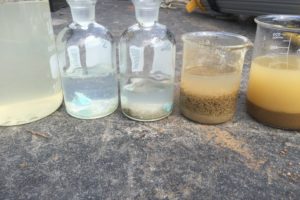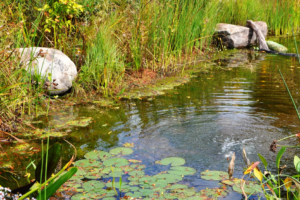Pond fountains are one of the most rewarding additions to your property. Installing a fountain in your pond adds a touch of elegance, relaxation, and peace to an outdoor space. Unfortunately, weather damage and wear-and-tear can lead to the need for preventive and corrective attention. Here are six tell-tale signs that pond fountain repair is needed.
1. Your Pond Fountain has Low Water Pressure
Low water pressure is one of the most common signs that your fountain needs repair. If your fountain is not producing the same amount of strong, jet-like streams as it once did, this problem may be due to a clog in the line or an issue with the pump.
Low water pressure can also be a result of insufficient power supply. To ensure this isn’t an issue, check the voltage and amperage supply to ensure it meets all requirements listed by your fountain’s manufacturer.
If there is corrosion on the pump motor or air bubbles in the lines, this can also cause low water pressure. Corrosion can happen over time with exposure to water and other environmental factors.
2. There Is Dirty or Discolored Water in Your Pond Fountain
Dirty or discolored water is another sign that your fountain needs repair. Over time, dirt and debris can build up in the water lines and pump, causing it to become dirty or discolored. Algae and other microorganisms can cause water discoloration. Cleaning the lines regularly will help prevent sediment and other types of buildup.
3. Algae Is Growing in Your Pond Fountain
Algae growth is one of the most common signs that your pond fountain requires repair. Algae can rapidly spread in a water garden due to its ideal environment, providing ample access to sunlight, oxygen, and nutrients from decaying matter. This can lead to the growth of green or yellow-colored algae blooms on the water’s surface and discoloration of the water itself.
As this alga accumulates, it can clog up filters and pumps, leading to inadequate water circulation and low oxygen levels in your pond. In some cases, this can even create an imbalance in your pond’s ecosystem that could be detrimental to fish and other aquatic life. Ongoing water management is necessary to keep algae growth at bay.
4. Your Pond Fountain Isn’t Working at All (It’s Definitely Time for Professional Fountain Repair!)
If your fountain isn’t working, it could indicate an electrical or pump issue. If you notice that your fountain is receiving power but not producing any water, this could be due to a broken or blocked impeller in the pump. The impeller is responsible for pushing water through the system and creating the necessary pressure for water jets to flow from your fountain. If it is blocked or broken, your fountain won’t work.
If there are damaged wires in the power box or faulty wiring connections, these can also cause the fountain not to work correctly. It’s essential to have a professional technician inspect and repair any issues related to electricity as soon as possible for safety reasons and to prevent further damage.

5. Noise Is Coming from the Pump of Your Pond Fountain
Noise coming from the pump is an indication that your fountain requires repair. The noise could be due to a range of factors, such as an impeller that has become jammed or clogged or a bearing in the motor that has become worn out. If these components are not operating correctly, this can cause undue noise and lead to further damage if not appropriately addressed.
Air bubbles within the lines can also contribute to loud noises from the pump. These bubbles indicate that there may be a blockage somewhere in the system. Improper pump maintenance can also lead to decreased efficiency and increased noise levels.
6. Leaks Also Indicate Fountain Repair Is Necessary
Water leaks often indicate a problem with the pump, valves, or hoses. If there is excess pressure buildup in the system, this can cause water to seep out from joints and seals. Check for any cracks or holes in the pipes that could lead to leaks. This type of damage can occur due to corrosion over time. If left unattended, cracks can worsen and cause more extensive damage.
Water flowing in the wrong direction indicates an issue with the pump, valves, or hoses, as these components control the water flow of your fountain. If a valve or hose becomes worn out, it can cause water pressure to drop, resulting in flow reversal. If there are any clogs within the system, this could cause an increase in pressure and result in a leak.
An obstruction in the line, such as a blockage or air bubble, can restrict water from flowing correctly and lead to it going against the natural direction intended for it to travel. This issue can be hazardous for fish and other aquatic life. It can trap them in areas of low oxygen and disrupt their natural habitat.
Looking for Expert Pond Fountain Repair?
Generally, all the problems listed above can be addressed by a professional technician with experience repairing pond fountains. If you have questions about your pond fountain, contact PondMedics for more information.





